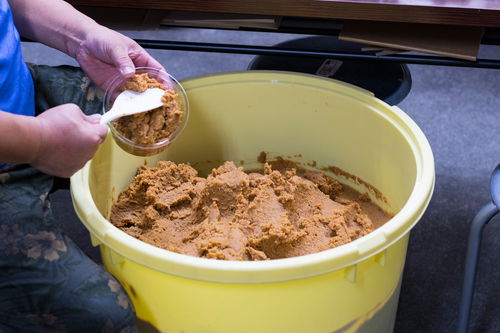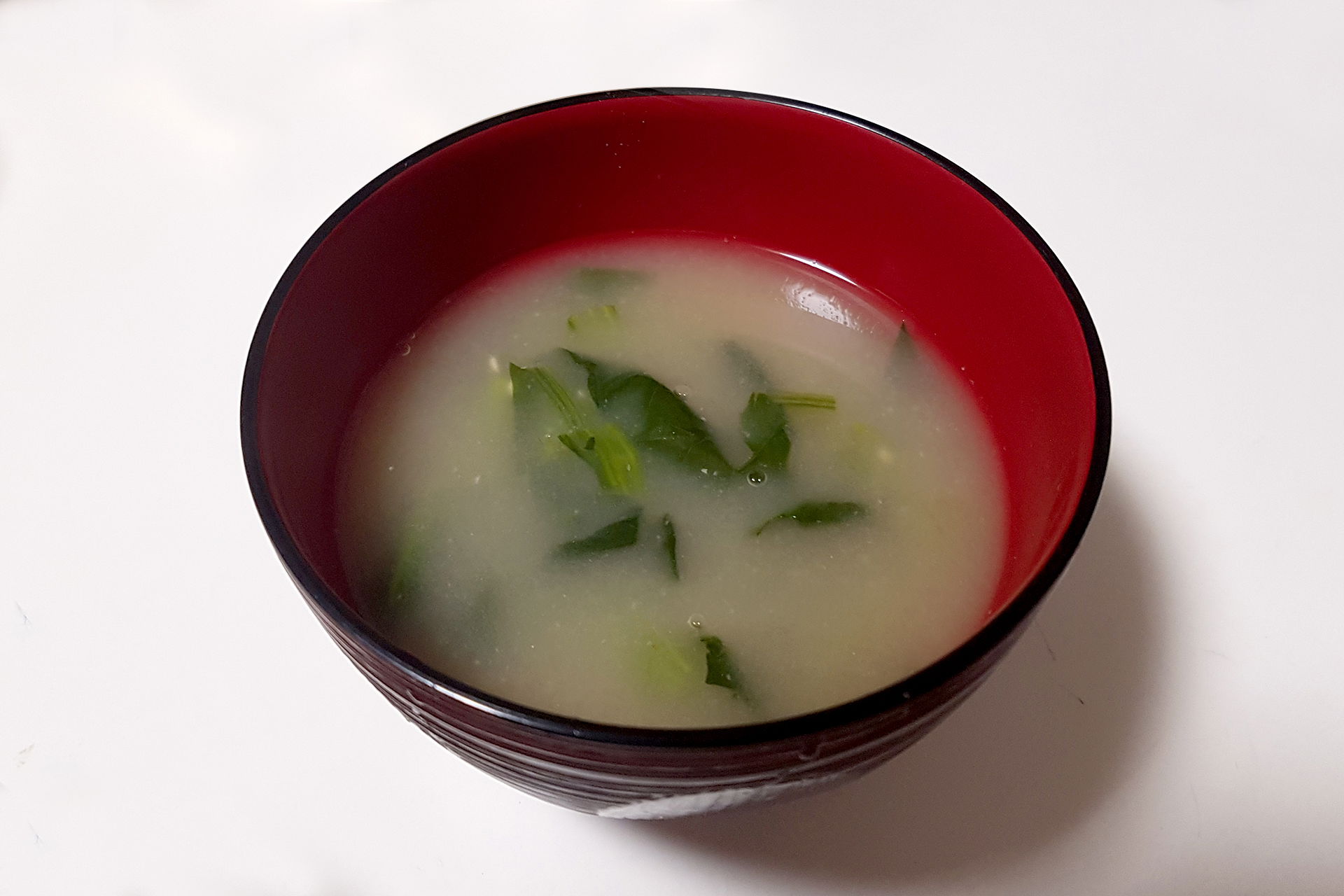40 have already made this dish!
The preparation:
-
Start by making Dashi. Either use instant Dashi, which you can prepare according to the package instructions. Or you can make Dashi yourself. It's not that hard! Here's a guide for that.
-
If you are using solid vegetables that need to soften first, cook them in the Dashi now.
-
Once they are soft, add the remaining ingredients, such as Wakame, (fried) tofu or cabbage.
-
Stir well and simmer for 5-10 minutes.
-
Now you can turn off the stove and add spring onions and miso paste.
-
The miso paste must dissolve completely in the water.
-
Now you just have to pour the soup into bowls, garnish and serve.
-
Serve the miso soup with rice or as a side dish to a complete Japanese menu. Bon Appetit!
Table of contents:
Besides ramen, miso soup - or miso shiru in Japanese - could well be the most authentic of all Japanese soups! It's part of almost every Japanese menu, acts as a light appetizer and is not only incredibly healthy, but also damn delicious! And it has one more advantage: You can easily cook miso soup at home. We'll tell you a truly authentic recipe here - it might even taste better than the miso soup you get at the Japanese restaurant next door!
What is miso soup made of?
Miso-shiru has only a few, perfectly balanced ingredients: water, dashi broth, miso, wakame seaweed, spring onions and tofu. But depending on the region and season, there are many variations of the classic miso soup. In addition, almost every family has its own miso recipe that has a slight individual twist.
In addition to the classic miso ingredients, other things can also be added to the soup - depending on your taste and preferences. By the way, if you don't know exactly what dashi broth is, we have a detailed article about it here:

You can easily prepare dashi in larger quantities, store it in the refrigerator for up to a week and then use it as you like in many Japanese recipes.
What is miso actually?
Miso is a fermented soybean paste. It is made from soybeans, grains, salt and the fungus Koji. Miso comes in different intensity levels, from very mild to extremely flavorful. These are distinguished by their color. For miso soup, you should use yellow or Awase-Miso. Caution: There are often differences in intensity and salt taste between the different brands. So take a little less miso at the beginning and then season to taste. Basically, one tablespoon of miso is used for about 200 ml of dashi. By the way, here we have a detailed article for you where you can learn everything about miso:

We recommend this miso:

What else goes into Shiro Miso?
Feel free to experiment here. Allowed is what tastes good! Different vegetables are great, for example:
- Leek
- Sweet potatoes
- Eggplant
- Cabbage (very delicious!)
- Mushrooms (Enoki, Maitake, Shiitake)
- Onions
- Spinach
- Carrots
- Bean sprouts
Meat and seafood also go well in Miso Shiro, for example:
- Beef
- Chicken
- Pork
- Mussels
Other possible ingredients:
- Sesame
- Aburaage (fried tofu)
- Egg
- Somen noodles
Well-known Miso Shiro variations
- Jagaimo Miso-Shiru: Potatoes, Tofu
- Kabocha Miso-Shiru: Pumpkin (Hokkaido Pumpkin)
- Hourensou Miso-Shiru: Spinach without Wakame
- Aburaage Miso-Shiru: Fried Tofu
Why is miso soup so healthy?
Miso Shiro is considered one of the secrets to the longevity of the Japanese! The delicious soup is extremely low in calories and only has about 100 calories per serving. It also provides many nutrients, such as zinc, vitamin K and manganese. It also has a lot of calcium and magnesium, both of which are excellent for bones. And finally, miso soup is considered to be very cholesterol-lowering.
How and when is miso soup served?
In Japanese restaurants in Europe, you often get miso soup as an appetizer, and therefore it is served before the main course. But in Japan, miso soup always comes to the table at the same time as the rice. It is therefore actually more of a side dish than an appetizer! Because of its mild taste, it is excellent for balancing salty dishes.
Tips:
- Never let miso soup boil after the miso has been added. Because of the cooking process, it loses a lot of aroma.
- This also applies to garnishes and herbs: These should be added only directly before serving.
- If you are using solid vegetables, you should first cook them in dashi until they are soft before adding other ingredients.



Comments
Hey Ryu, super Rezept :) Ich finde dieses Rezept, auch wenn es sehr einfach ist, sehr lecker und autentisch VG Kevin
Hallo, danke für die interessanten Infos zur Miso-Suppe! Frage zur Zubereitung: in eurem Rezept fehlt die Dashi-Paste und den (Frühlings)Zwiebel fügt ihr 2x hinzu. Könnt ihr da bitte noch etwas Klarheit reinbringen? Ich vermute mal, dass die Dashi und Miso-Pasten zeitgleich reinkommen und der Frühlingszwiebel erst ziemlich am Schluss? Liebe Grüße, Christian
Warum kocht ihr das Miso denn mit? Das soll eigentlich nicht in kochendes Wasser, weil sonst Aromen verloren gehen.
Super Seite ich bin begeistert alles super lecker und gut beschrieben
Hi, Ich habe mir grade die Miso-Suppe gemacht und ich bin echt begeistert. Sehr einfach zu machen und sehr lecker :-) Ich würde sie gern etwas variieren und etwas Abwechslung hineinzubringen wenn ich sie öfters esse (was ich mit Sicherheit machen werde). Was denkst du darüber, den Tofu oder einen Teil davon auszutauschen und statt dessen etwas gebratenes (oder gekochtes) Hühnerfleisch in die Suppe zu machen? Gruß Marco
Obwohl ich eine absolute Null im Kochen bin, hab ich das Rezept heute mit Shiitakepilzen und Kohl ausprobiert. Superlecker! Das kommt jetzt öfter auf den Tisch :)
Hallo, Ein kleiner Hinweis: wenn man die verlinkte Dashi-Brühe verwendet, ist die Suppe nicht laktosefrei!
Ich wollte heute mal ein einfaches japanisches Frühstück ausprobieren und habe mir die Miso-Suppe in der Basis-Variante mit Tofu, Frühlingszwiebeln und Wakame gemacht. Es wurde etwas zu salzig. War das zu viel Misopaste oder zu viel Dashi-Pulver? Es schmeckte ansonsten sehr gut und ich werde in Zukunft auf jeden Fall Versionen mit mehr Gemüsesorten probieren. Die Menge von 200g Tofu pro Person finde ich im Verhältnis zur Flüssigkeit aber zu groß. Ich hab nicht mal die Hälfte verwendet. Dazu gab es Tamago Kake Gohan, was trotz der Einfachheit des Rezepts erstaunlich gut war.
Ich hab Misosuppe jetzt schon ein paar Mal mit verschiedenen Einlagen nach gekocht. Meist nehme ich sie als Beilage zu einem japanischen Hauptgericht und Reis. Meine letzte Version: Klein gewürfelte Champignons, TK-Spinat und Frühlingszwiebeln. Schmeckt fantastisch und braucht nicht mehr Zeit und Aufwand als ein Fertiggericht.
Wenn die verlinkte Dashi Geschmacksverstärker enthält, ist das Rezept echt fail, bzw. schlecht recherchiert. Oder in Dashi ist Geschmacksverstärker authentisch .. :(